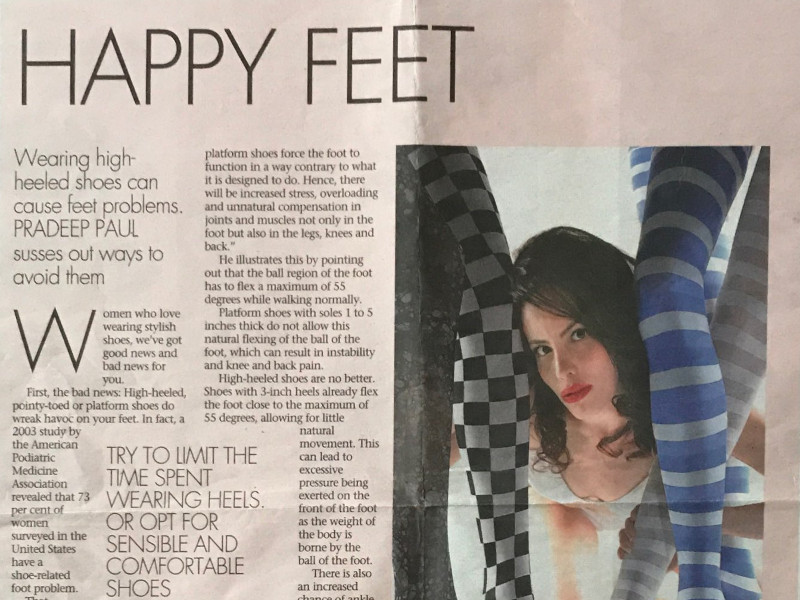Wearing high-heeled shoes can cause feet problems. PRADEEP PAUL susses out ways avoid them
Women who love wearing stylish shoes, we’ve got good news and bad news for you.
First, the bad news: High-heeled, pointy-toed or platform shoes do wreak havoc on your feet. In fact, a 2003 study by the American Podiatric Methane Association revealed that 7. per cent of women surveyed in the United States have a shoe-related foot problem.
That translated to an annual bill of USS3.5 billion for foot ailment-related surgery in the US itself.
No similar study has been done in Singapore.
Podiatrist Tye Lee Tze, who run The Podiatry Centre at Tanglin Place, says the more common problems associated with fashionable shoes are:
- Bunions and bunionettes (nearly Ilse times more women have bunions than men in the US).
- Corns and calluses (nearly times more women have corns and calluses than men in the US).
- Hammer and claw toes (toes that lose their normal shape and become claw-like)
- Ingrown, thickened or blackened toenails.
- Other problems can include metatarsalgia (pinched nerves in the front of the foot caused by pointy-toed shoes), pain under the ball of the foot caused by the extra pressure exerted on that area by wearing high-heeled shoes, ankle instability and sprains as well as heel pain.
Tye says: “Both high heels and platform shoes force the foot to function in a way contrary to what it is designed to do. Hence, there will be increased stress, overloading and unnatural compensation in joints and muscles not only in the foot but also in the legs, knees and back.”
He illustrates this by pointing out that the ball region of the foot has to flex a maximum of 55 degrees while walking normally. Platform shoes with soles 1 to 5 inches thick do not allow this natural flexing of the ball of the foot, which can result in instability and knee and back pain.
High-heeled shoes are no better. Shoes with 3-inch heels already flex the foot close to the maximum of 55 degrees, allowing for little natural movement. This can lead to excessive pressure being exerted on the front of the foot as the weight of the body is borne by the ball of the foot.
There is also an increased chance of ankle sprains and pain in the heel of the foot if the shoe is stiletto-heeled.
The late Dr Paul Brand, an American who was Emeritus Professor of Orthopaedics at the University of Washington, evaluated that the force, per square inch, exerted by a 50kg woman standing on heels %-inch wide is greater than the force exerted by an adult elephant standing on its four broad foot pads.
According to Tye, foot problems may not occur immediately but could appear later in life, sometimes even 20 years later.
A common problem faced by those who wear high heels a lot is “accommodative shortening of the calves” – the calves shrink in length and can result in chronic Achilles tendon and calf pain.
This is why some women who have worn high heels for a long time cannot wear flats – their calves will not stretch that far.
If you do have to wear heels -82 pet cent of the women surveyed in the US said they were willing to sacrifice the health of their feet for fashion – try to limit the time spent wearing them.
TRY TO LIMIT THE TIME SPENT WEARING HEELS. OR OPT FOR SENSIBLE AND COMFORTABLE SHOES
Tye’s suggestion: Wear your heels from the house to the car, but take them off in the car. Or, if you’re sitting at a table, slip out of your shoes discreetly.
Or you could opt for sensible and comfortable shoes that have lower, broader heels and a wider toebox.
Now, here’s the good news: You can do some exercises to help your feet deaf with these fashionable heels.
Tye recommends stretching the calf muscle and the Achilles tendon to counter the pain.
lf the pain is located in the heel or the arch of the foot, try rolling a golf ball under the arch with reasonable pressure for approximately five minutes with each foot.
You can also place a towel on the ground and scrunch it up with your toes. Once you get accustomed to this, try scrunching Lip the towel with a small book placed on it to act as a weight. Then progressively move to a bigger book.
You can also pick up objects with toes.
Lee Tze can be contacted at The Podiatry Centre, 02-05 Tanglin Place, 91 Tanglin Road, tel 68384757.
E-mail: thepodiatryctr@pacific.net.sg.
By Pradeep Paul. Originally posted in The Straits Time, October 25, 2007.

